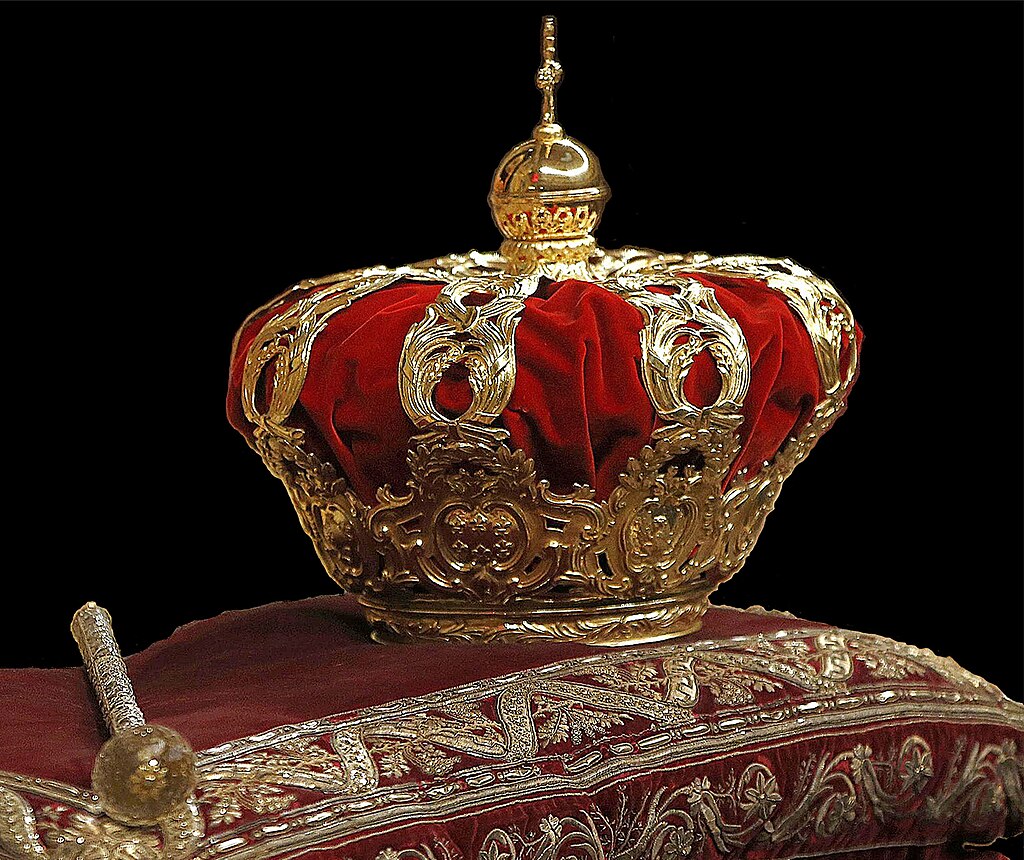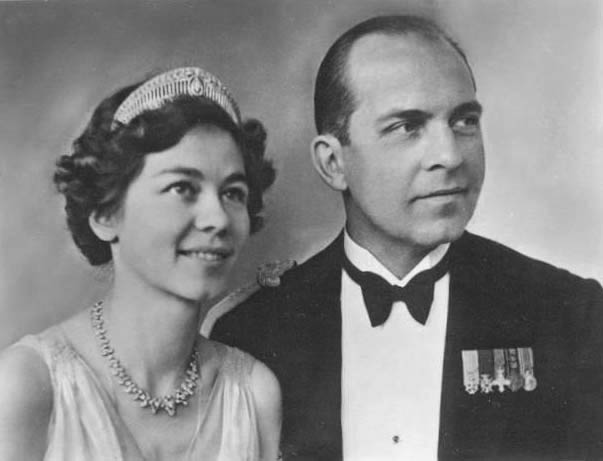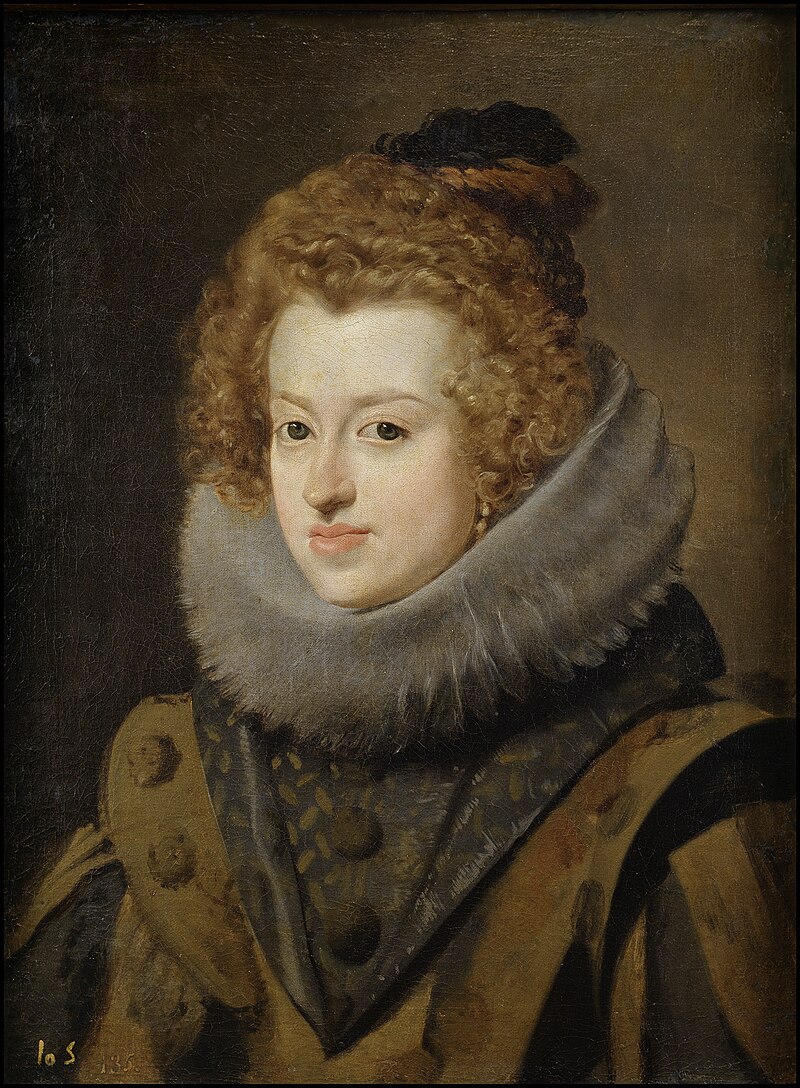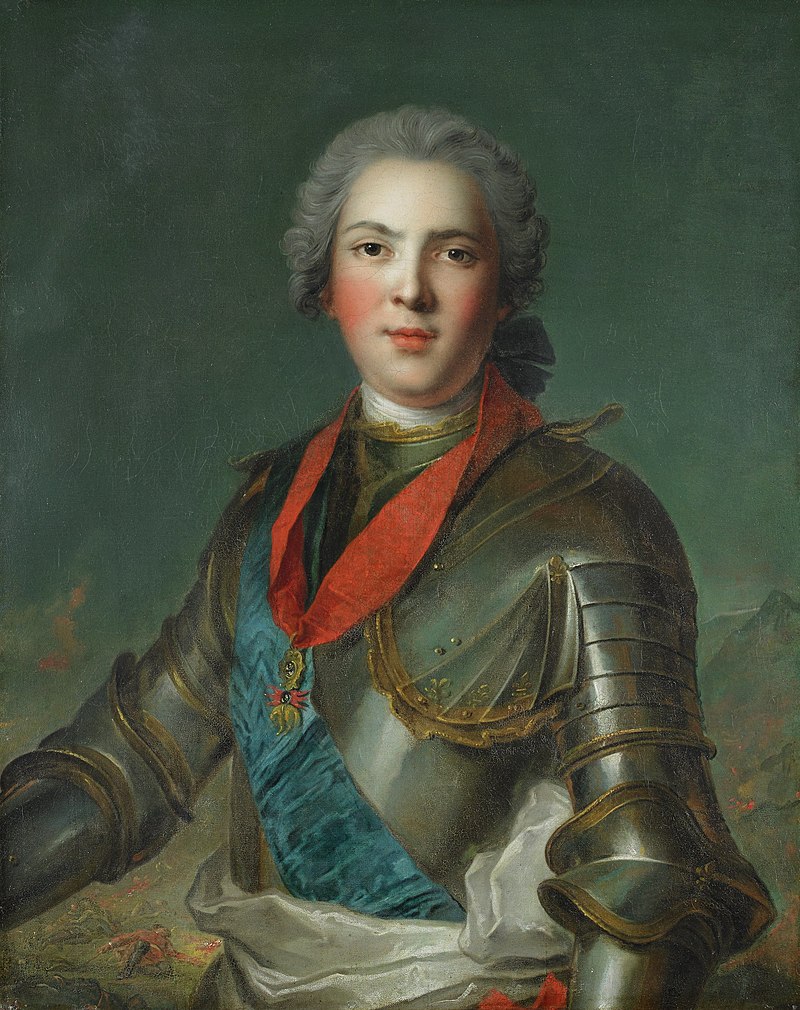by Susan Flantzer
© Unofficial Royalty 2024

Columbus taking possession of what is now Guanahani in the Bahamas in the name of the Catholic Monarchs, Queen Isabella I of Castile and her husband King Ferdinand II of Aragon, on October 12, 1492; Credit – Wikipedia
The National Day of Spain (Fiesta Nacional de España) is celebrated on October 12, the day in 1492, when Christopher Columbus went ashore at Guanahaní, an island in the Bahamas, that Columbus called San Salvador. The discovery of the Americas on October 12, 1492, has been considered an important historical day because contact between America and Europe began, transforming the world views and lives of both Europeans and the indigenous peoples of the Americas, and the European colonization of the Americas began. Christopher Columbus always believed that he had reached what we now call Asia without suspecting that he had stumbled upon a new continent. Explorer Amerigo Vespucci claimed to have understood in 1501 that Brazil was part of a fourth continent unknown to Europeans, which he named the “New World”. October 12 symbolizes Spain’s common heritage with today’s Latin American countries, which made up the Spanish Empire, the first global power in world history.
History

Our Lady of the Pillar appearing to Saint James and his disciples by Francisco Goya; Credit – Wikipedia
The first celebration in Spain of the discovery of the Americas by Christopher Columbus was in 1642 when the city of Zaragoza (also known in English as Saragossa) in Aragon, Spain designated Our Lady of the Pillar as a symbol of Hispanidad (Hispanicity) on the date of Columbus’ arrival in the New World. Our Lady of the Pillar (Spanish: Nuestra Señora del Pilar) is the name given to the Blessed Virgin Mary in the context of the traditional belief that Mary, while living in Jerusalem, supernaturally appeared to the Apostle James the Greater in 40 AD while he was preaching on the banks of the Ebro River at Caesaraugusta, now Zaragoza, Spain. In 1730, the religious feast day of Our Lady of the Pillar was declared a holiday throughout the Spanish Empire.

Our Lady of the Pillar wooden statue at the Basilica of Our Lady of the Pillar in Zaragoza, Aragon, Spain; By CARLOS TEIXIDOR CADENAS – Own work, CC BY-SA 4.0, https://commons.wikimedia.org/w/index.php?curid=63861797
This title is also associated with a wooden statue commemorating Mary’s apparition, enshrined at the Basilica of Our Lady of the Pillar in Zaragoza, Aragon, Spain. The traditional belief is that the Blessed Virgin Mary gave James the Greater a column of jasper and instructed him to build a church in her honor: “This place is to be my house, and this image and column shall be the title and altar of the temple that you shall build.” The wooden statue at the Basilica of Our Lady of the Pillar depicts Mary and the Child Jesus with a dove sitting on his left palm. The statue is 15 inches/39 centimeters tall and stands on a pillar of jasper 5.9 feet/1.8 meters tall.

Maria Christina of Austria, Queen of Spain; Credit – Wikipedia
On September 23, 1892, Queen Maria Cristina, the widow of King Alfonso XII of Spain who died in 1885, and the Regent for her six-year-old son King Alfonso XIII of Spain, issued a royal decree declaring October 12, 1892, a one-time national day in commemoration of the 400th anniversary of Christopher Columbus’ discovery.
The Discovery of America and Hispanidad has been celebrated as a national day since 1918 under different names like “Día de la Hispanidad” or “Dia de la Raza” due to changes in political regimes in Spain during the 20th century. Spanish National Day emphasizes Spain’s ties with the Hispanidad, the international Hispanic community, and Spain’s legacy to the world. In 1981, a royal decree issued by King Juan Carlos I established the Fiesta Nacional y Día de la Hispanidad as a national holiday. In 1987 the name was changed to Fiesta Nacional de España and October 12 became one of two national celebrations, along with Constitution Day on December 6. The removal of Hispanidad aimed to avoid any controversy regarding the conquest, influence, and rule of the Americas by Spain.
October 12 is also an official holiday in much of Latin America under different names, celebrating the historical and cultural ties among Hispanic American countries, ties with Spain, and their common Hispanic and pre-Hispanic indigenous American heritage. However, in some Latin American countries, the emphasis has been removed from the “discovery of America” that many see as causing the abuse and genocide of the indigenous people of the Americas. In the United States, on the second Monday in October, Columbus Day, a federal holiday, is celebrated. Similar to the sentiment in some Latin American countries, a number of places in the United States instead celebrate Indigenous Peoples’ Day.
The controversy regarding the Spanish conquest of the indigenous peoples of the Americas continues. In 2019, Mexico’s president Andrés Manuel López Obrador wrote to King Felipe VI of Spain and Pope Francis, calling for them to apologize for the abuses committed by the Kingdom of Spain and the Roman Catholic Church during the Spanish conquest and the colonial period. In 2024, Mexico’s president-elect Claudia Sheinbaum refused to invite King Felipe VI of Spain to her inauguration because he failed to apologize for crimes committed against Mexico’s indigenous people during the Spanish conquest 500 years ago.
What Happens?
Leonor, Princess of Asturias (heir presumptive to the throne), King Felipe VI, and Queen Letizia attend the National Day Military Parade in Madrid, Spain on October 12, 2023
Official and cultural celebrations take place throughout Spain on National Day. Despite Día de la Hispanidad (Day of Hispanicity) being removed from the holiday’s name, the tradition of celebrating Hispanicity is still observed in Spain and celebrated by Hispanic people worldwide. The main celebrations take place in Madrid, the capital of Spain. Since 2000, October 12 has also been Spain’s Day of the Armed Forces, celebrated each year with a military parade in Madrid.
Military Parade

The Military Parade, 2014 Fiesta Nacional de España; Credit – WIkipedia
The Spanish Armed Forces and the State Security Forces (law enforcement) participate in a parade in Madrid, attended by the Spanish Royal Family, the Prime Minister of Spain, leaders of the Cortes Generales (the Spanish legislature), members of the Supreme Court of Spain, members of the cabinet, other representatives of the central government and the governments of the autonomous communities of the state. Thousands of Spaniards gather along the parade route. At 9:00 AM, the Royal Guards Honors Battalion forms up at the front of the royal dais where the military and governmental members have assembled, awaiting the Spanish Royal Family’s arrival.

The Royal Family of Spain and dignitaries on the dais watching the military parade in 2008. Credit – By Ministry of the Presidency. Government of Spain, Attribution, Link
At 10:00 AM, the Royal Family arrives. The Royal Guards Band plays the Marcha Real, the Spanish national anthem, one of four national anthems without lyrics. The Royal Guard Battalion presents arms and a 21-gun salute is fired. The Spanish monarch and his/her spouse inspect the Royal Guards Honors Battalion while the band plays music. The Spanish monarch and his/her spouse proceed to the dais to meet the gathered government leaders. The Chief of Defense Staff asks the Spanish monarch for permission to begin the ceremony.
Embed from Getty Images
The Spanish Air and Space Force Aerobatics Parachute Unit performs a jump from an aircraft while carrying a massive Spanish flag, landing in front of the Spanish royal family sitting on the dais. The tribute to the national flag follows, with its raising while the national anthem, the “Marcha Real,” is performed

Spanish Air and Space Force’s aerobatics team, the Patrulla Águila; Credit – Nils van der Burg from Madrid, Spain 12 Oct 2009 – Día de la Hispanidad
A tribute is paid to the soldiers who have given their lives for Spain, followed by the military parade, ending with a flypast display by the Spanish Air and Space Force’s aerobatics team, the Patrulla Águila.
Spanish Culture
Throughout Spain, there are many public and private events honoring Spain’s heritage, history, society, and people. People can be seen dressed in traditional regional and historic dress. Folk, classical, and modern music concerts, and street shows are well attended. Latin American communities in Spain participate in parades, displaying their national flags and wearing their countries’ historic dress while their countries’ folk music is played. Museums and historical sites have an Open Doors Day, allowing all to enter free.
Religious Aspect
October 12 is the feast day of both Our Lady of the Pillar (explained above) and Our Lady of Guadalupe in Extremadura, names given to the Blessed Virgin Mary. Because their feast days are on October 12, they have become related to Christopher Columbus and the National Day of Spain.
Our Lady of the Pillar is the Patroness of Aragon, Spain and its capital Zaragoza, Patroness of the Hispanic people, Patroness of the Hispanic world, and Patroness of the Spanish Civil Guard. The Basilica of Our Lady of the Pillar is in Zaragoza, Spain. A nine-day festival known as Fiestas del Pilar is celebrated in Zaragoza, Spain every year in her honor, beginning on the weekend preceding October 12.

Offering of flowers to the Virgin Mary in front of the Basilica of Our Lady of the Pillar in Zaragoza, Spain; Credit – By Ecelan – Own work, CC BY-SA 4.0, https://commons.wikimedia.org/w/index.php?curid=3829351
On October 12, many people from other Spanish regions go to Zaragoza, where the traditional “Ofrenda de flores a la Virgen” (Offering of flowers to the Virgin Mary), a large parade with many participants including from Latin American communities, takes place all day long.
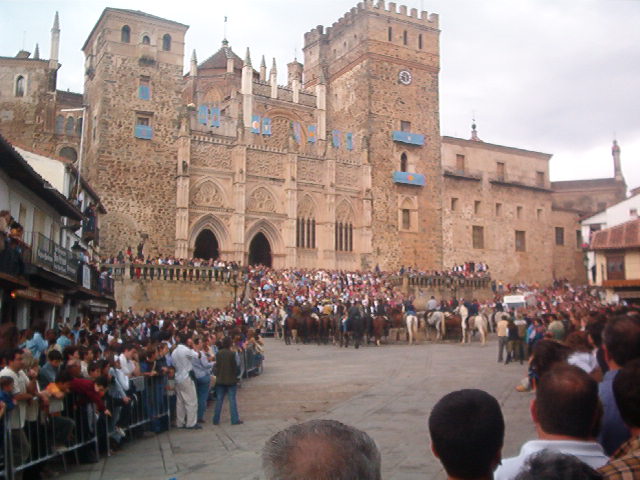
National Day of Spain celebrations at the Our Lady of Guadalupe in Extremadura. Spain; Credit – Wikipedia
Our Lady of Guadalupe in Extremadura is a shrine to the Blessed Virgin Mary at the Monastery of Santa María de Guadalupe in Cáceres, Spain. A statue of Mary is reputed to have been carved by Saint Luke the Evangelist and given to Saint Leander, Archbishop of Seville by Pope Gregory I. According to local legend, in 712, during the Muslim conquest of the Iberian Peninsula, when Seville was defeated, a group of priests fled and buried the statue in the hills near the Guadalupe River in Extremadura, Spain. In the early 14th century, the Blessed Virgin Mary reputedly appeared to a cow herder named Gil Cordero while he was searching for a missing cow in the mountains. Cordero claimed that Mary ordered him to ask priests to dig at the place of her apparition. The priests discovered the hidden statue and built a small shrine which became the nucleus of the present monastery.

The statue of Our Lady of Guadalupe in Extremadura; Credit – Wikipedia
The statue was carved from cedar wood and is two feet high. It is a Black Madonna, a statue or painting of the Blessed Virgin Mary and the Infant Jesus, where both are depicted with dark skin. Since the late 14th century, the statue has been clothed in embroidered and brocaded clothing, leaving only the faces and hands of the Blessed Virgin Mary and the Infant Jesus visible.
There is a connection to Our Lady of Guadalupe in Extremadura and Christopher Columbus. Queen Isabella I of Castile and her husband King Ferdinand II of Aragon signed the documents that authorized the first voyage of Columbus to the Americas at the Monastery of Santa María de Guadalupe. Upon his return to Spain, Columbus went to the monastery to give thanks for a safe voyage.
This article is the intellectual property of Unofficial Royalty and is NOT TO BE COPIED, EDITED, OR POSTED IN ANY FORM ON ANOTHER WEBSITE under any circumstances. It is permissible to use a link that directs to Unofficial Royalty.
Works Cited
- Colaboradores de los proyectos Wikimedia. (2006). fiesta nacional de España. Wikipedia.org; Wikimedia Foundation, Inc. https://es.wikipedia.org/wiki/Fiesta_Nacional_de_Espa%C3%B1a
- National Day of Spain. (2021). Wikipedia. https://en.wikipedia.org/wiki/National_Day_of_Spain
- Wikipedia Contributors. (2019). Columbus Day. Wikipedia; Wikimedia Foundation. https://en.wikipedia.org/wiki/Columbus_Day
- Wikipedia Contributors. (2024). Our Lady of Guadalupe in Extremadura. Wikipedia; Wikimedia Foundation. https://en.wikipedia.org/wiki/Our_Lady_of_Guadalupe_in_Extremadura
- Wikipedia Contributors. (2024). Our Lady of the Pillar. Wikipedia; Wikimedia Foundation. https://en.wikipedia.org/wiki/Our_Lady_of_the_Pillar








